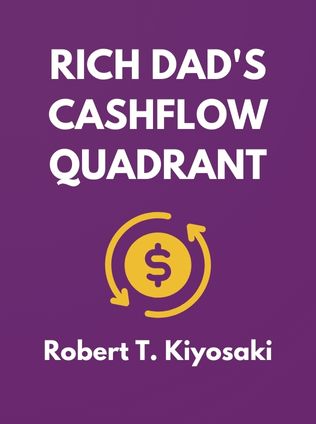
Rich Dad's Cashflow Quadrant
Rich Dad's Guide to Financial Freedom
By Robert T. Kiyosaki
Published 03/2012
About the Author
Robert Kiyosaki is a name synonymous with financial education and personal development. Known for his unconventional approach to wealth-building, Kiyosaki has authored numerous bestsellers, including the acclaimed “Rich Dad, Poor Dad.” His books have transformed the financial lives of millions, promoting a mindset shift from traditional income models to the pursuit of financial freedom through entrepreneurship and investing. Kiyosaki’s insights are largely drawn from his own life experiences, as well as the influence of his "Rich Dad," a friend’s father who served as his mentor in financial matters.
Kiyosaki’s background is as varied as it is impressive. He served in the Marine Corps during the Vietnam War, later becoming a successful entrepreneur. His ventures in business, ranging from education to retail, have all contributed to the wisdom he shares with his readers. Through his books, seminars, and financial games like “CASHFLOW,” Kiyosaki teaches principles that challenge conventional wisdom about money, work, and education.
Main Idea
The core of Rich Dad's Cashflow Quadrant revolves around the concept of financial independence through the understanding of four distinct categories of income generation. Kiyosaki introduces the “Cashflow Quadrant,” a model that categorizes the different ways people earn income into four types: Employee (E), Self-Employed (S), Business Owner (B), and Investor (I). According to Kiyosaki, the path to financial freedom lies in shifting from the left side of the quadrant (E and S) to the right side (B and I), where passive income streams lead to wealth accumulation and freedom from the daily grind.
This book is a call to arms for anyone tired of the traditional work model and looking to break free from the limitations of trading time for money. Kiyosaki emphasizes the importance of financial literacy, asset acquisition, and the development of a mindset geared towards wealth creation rather than mere survival.
Table of Contents
- Introduction to the Cashflow Quadrant
- The Evolution of Wealth
- The E and S Quadrants: The Traditional Path
- The B and I Quadrants: The Path to Wealth
- Why Financial Literacy Matters
- Strategies for Becoming a Business Owner
- Becoming a Successful Investor
- Developing the Mindset for Wealth
- Conclusion: Your Path to Financial Freedom
Introduction to the Cashflow Quadrant
At the heart of Rich Dad's Cashflow Quadrant lies the framework of the four income-generating categories. Kiyosaki explains that most people fall into the Employee (E) or Self-Employed (S) categories. These categories represent individuals who exchange their time and skills for money, often in a direct, linear fashion. However, true financial freedom is found on the right side of the quadrant, in the Business Owner (B) and Investor (I) categories. Here, income is derived from assets that generate money passively, without the need for continuous personal involvement.
Kiyosaki’s fundamental argument is that the type of income you earn is more important than the amount. He states,
“It’s not how much money you make, but how much money you keep, how hard it works for you, and how many generations you keep it for.” - Robert Kiyosaki
In essence, moving from active income to passive income is the key to breaking free from the constraints of the traditional job model.
The Evolution of Wealth
Kiyosaki argues that traditional pathways to wealth, such as working a stable job and saving diligently, are outdated and insufficient in today’s economy. He points out that job security is a thing of the past, with fewer guarantees for long-term employment and retirement benefits. The economic landscape has shifted, making it imperative for individuals to adapt by developing multiple income streams and focusing on asset acquisition.
Sign up for FREE and get access to 1,400+ books summaries.
You May Also Like
The Subtle Art of Not Giving a F*ck
A Counterintuitive Approach to Living a Good Life
By Mark MansonRich Dad Poor Dad
What the Rich Teach Their Kids About Money - That the Poor and Middle Class Do Not!
By Robert T. KiyosakiHow To Win Friends and Influence People
The All-Time Classic Manual Of People Skills
By Dale CarnegieQuiet: The Power of Introverts
The Power of Introverts in a World That Can't Stop Talking
By Susan Cain



















